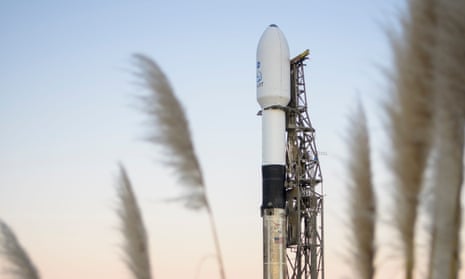Nasa is preparing to launch its $330m Double Asteroid Redirection Test (Dart) probe, testing the space agency’s ability to alter an asteroid’s trajectory with kinetic force.
The plan is to crash a robot spacecraft into the moonlet Dimorphos at 15,000 mph and change its path just a fraction. If the mission is successful, it will mean that Nasa and other space agencies could deflect an asteroid heading towards Earth and avert an Armageddon-style impact.
What is happening?
At 1.20am Eastern time the Dart spacecraft is scheduled to lift off atop a SpaceX Falcon 9 rocket from a launchpad in California. If liftoff is postponed Nasa has an 84-day launch window in which to try again.
It will take 10 months to travel the 6.8m miles to Dimorphos and the collision will not take place until September-October 2022.
Dimorphos is a football-field-sized asteroid that closely orbits a bigger asteroid, called Didymos. Neither pose a threat to Earth. Nasa is simply undertaking some target practice with the Didymos system because its relative proximity to Earth makes it ideal to observe the results of the impact.
Before the crash, an Italian-made satellite called LICIACube will sensibly bail out from Dart and position itself nearby to send pictures and data back to Earth.
Will it work?
LICIACube’s pictures and telescope observations from Earth should give some indication of whether Dimorphos’s orbit has been altered. The goal is only to move it a fraction of a percentage point.
Observations from ground-based telescopes and radar will then measure how much the moonlet’s orbit around Didymos changes.
Why can’t they just blow it up?
Disappointingly – or perhaps reassuringly – Nasa will not anytime soon be lowering Bruce Willis and Ben Affleck to the surface of asteroid to (spoilers ahead if you’re joining us from 1997) drill a hole, drop in a nuclear bomb and then try to get away quick enough.
If an asteroid were to actually threaten Earth, it would be a good idea to identify it early on and knock it off course, because the earlier that alteration to its trajectory can be made, the further away from Earth it will hopefully end up.
The key to avoiding a killer asteroid is to detect it well in advance and be ready with the means of changing its course, Nasa planetary defence officer Lindley Johnson told a media briefing this month. “We don’t want to be in a situation where an asteroid is headed toward Earth and then have to be testing this kind of capability,” he said.
There are lots of other ideas including running a spaceship alongside and using a laser, ion engine jet or other kind of beam device to exert a slight but significant-over-time effect. Or a robotic lander could mine and then eject material from the surface (mass-driver effect), using Newton’s third law of action and reaction to change the course. Solar sails could be hoisted nearby to reflect enough sunlight on to the object to have an effect.
